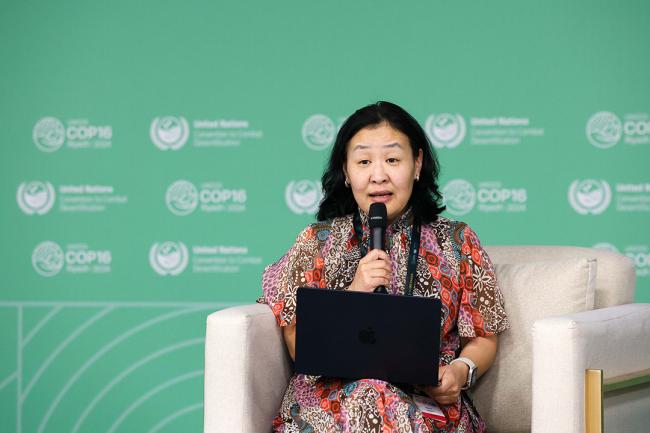About
How does fashion drive land degradation and what are the solutions? The UN Convention to Combat Desertification presented its first-ever event dedicated to this important question.
For the first time in its history, the UN Convention to Combat Desertification (UNCCD) hosted a discussion that zeroes in on the connections between fashion and land degradation. Featuring a wide range of experts and high-level participants, this event showcased multiple examples of scalable solutions across the value chain, as well as policy and market mechanisms to foster a more sustainable and land-friendly fashion industry.
Inna Modja, UNCCD Goodwill Ambassador, moderated the event, which kicked off with a clarion call from Ibrahim Thiaw, UNCCD Executive Secretary, who urged participants to avoid buying new clothes if they don’t need them. He pointed out that only 2% of clothes are currently recycled, and up to 92 million tons of clothes are thrown away every year, most of which end up in landfills.
Inger Andersen, Executive Director, UN Environment Programme (UNEP), cautioned that textile utility, a measure of how long clothes are used, has gone down by 20% since 2015, which means people are throwing away clothes faster, partly due to the convenience of online shopping. In addition to paying attention to which materials are used in fashion purchases, she also urged consumers to focus not only on the materials going into the clothes they buy, but also to labor rights and exploitation—issues that disproportionately affect women.
The first panel discussion focused on “Joining Forces for Land-Friendly Fashion.” Ariuntuya Dorjsuren, Ministry of Environment and Tourism, Mongolia, and consultant for the Working Group for COP 17, which will be hosted by Mongolia, said her government has an initiative to raise production standards for fibers, cashmere, and wood, such that all negative impacts on land are mitigated. She noted that cashmere is a critical sector for Mongolia, and is considered to be a key lever for ecological restoration through community engagement and participation.
Alexandre Capelli, Deputy Director of the Environment Department, LVMH Group, said his company is implementing solutions to recycle cotton, wool, and cashmere, including through a pilot collection created in 2023 entirely from unsold products. Among successful pilots in recent years with potential to scale, he referenced a project in Turkey to accelerate regenerative practices in cotton by reducing pesticide use and adding more soil cover, and a project in Lake Chad, focusing on introducing agroforestry into cotton production to fight drought and desertification. However, he cautioned that regenerative agriculture is the “haute couture” of agriculture, meaning that every project has to be adapted to its specific terrain and appropriate practices.
Burak Cakmak, CEO, Saudi Fashion Commission, talked about working with local brands and creators—including connecting them with industry partners—to build their businesses in a sustainable manner. He mentioned the need for more data on the region’s value chain and industry practices to inform infrastructure projects on sustainability to combat land degradation.
Una Jones, CEO, Sustainable Fibre Alliance, described efforts in Mongolia to empower and support herders in their transition to more sustainable grazing practices that include animal health and welfare. She explained that, in Mongolia, one-third of the population are herders, 80% of their livelihoods depend on the cashmere supply chain, and the cultural heritage aspect of herding is important.
In the second panel on international collaboration and innovative solutions for sustainable fashion, Cristina de Avila, Head of Unit, Global Environmental Cooperation and Multilateralism, European Commission, said that regional and national action in global supply chains can make a difference, including at the global level. She outlined measures currently in place in Europe, such as: recyclability requirements that allow textiles to remain in use for longer; better information for consumers and the value chain; and measures requiring producers to take responsibility for any waste they create.
Liliana Annovazzi-Jakab, Chief of the Joint ECE/FAO Forestry and Timber Section, Forests, Land, and Housing Division, UN Economic Commission for Europe (UNECE), described the “Forest for Fashion” initiative which relies on using low-grade wood-based fibers. She explained that, unlike cotton, such fibers do not require irrigation, and they are sourced from sustainably managed forests.
Alex Musembi, General Manager, Africa Collect Textiles, urged the Global North to support Africa to develop the necessary infrastructure to collect, sort, and process textiles. He added that recycling can be promoted by paying attention to how materials are made, noting, for example, that textiles made from mixed blends are the most difficult to recycle.
Xenya Scanlon, Chief of Communications, External Relations and Partnerships, UNCCD, announced the launch of a publication about land, fashion, and the environmental impacts of fibers. Several speakers highlighted the importance of the International Year of Rangelands and Pastoralists (IYRP) in 2026 to shine a light on this theme. IYRP Co-Chair, Carlos Enrique Michaud López, noted the importance of this initiative to channel investments to this ecosystem and the livelihoods of people involved, as well as the cultural heritage they hold, which is critical to combat desertification.
Paul Garaycochea, Director for Sustainable Supply Chains, Agricultural Food Systems, German Federal Ministry for Economic Cooperation and Development (BMZ), recalled that rangelands cover half the world’s land surface. He noted that BMZ supports this initiative as it will drive greater attention to rangelands.
Ismahane Elouafi, Executive Managing Director, CGIAR, issued a call to action on seeking to understand nature as one whole, not as separate silos where fashion, water, land, rangelands are tackled separately.
Organizer: UNCCD and UNEP, in collaboration with the Sustainable Fibre Alliance, the Fashion Commission of Saudi Arabia, UNECE, the European Union, and the UN Alliance for Sustainable Fashion
Contact: Claire Thiebault, Programme Management Officer, UNEP, claire.thiebault@un.org
Website: https://www.unep.org/events/unep-event/fashion4land-side-event-unccd-cop16
To receive free coverage of global environmental events delivered to your inbox, subscribe to the ENB Update newsletter.
All ENB photos are free to use with attribution. For UNCCD COP 15 Side Events, please use: Photo by IISD/ENB | Anastasia Rodopoulou













